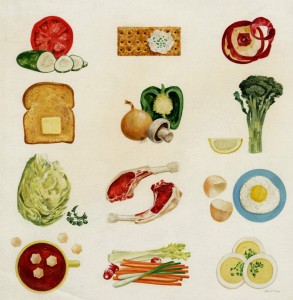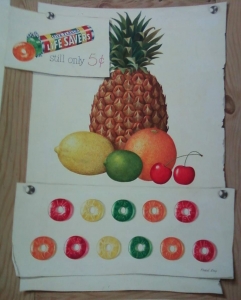
Fred Eng (1917-1995) | Food Illustrations, n.d. | Illustration for unknown purpose | Gouache on paper | Norman Rockwell Museum Collection, gift of the Eng Family, NRM.2012.4.89
Lately I’ve been inundated by a variety of work that I would like to call yummy art—art that pictures edible things such as this mid 20th century illustration by Fred Eng. The illustration pictured is a group of twelve images painted on one sheet of paper. Since there was no information accompanying this object, we do not know if it was created to illustrate an article on food, a group of recipes, or signs for a grocery store. What we are then left with is a fantastic image of wonderfully painted foods.
Click on the illustration and look at a larger version of the painting so you can see the skill Eng used to recreate the warm golden toasting of the bread’s airy surface; the way a knife has cut and lifted the peel of apple and the way it sometimes drags against the apple’s already browning surface causing the edge of the peel to ripple with the shift; the various shades of green Eng employed to make the image of a stalk of broccoli or a head of lettuce; and his visual understanding of the difference between the look of an egg cooked over-easy and slices of one hard boiled.
This illustration and others by Eng were gifts to the Norman Rockwell Museum by Eng’s family, including the image below created for a Life Savers candy advertisement. Eng constructed this ad as though it is a series of concept art images tacked to a paneled wall. Using the image of an actual roll of Life Savers in the title and tagline at the top left of the illustration, he then goes on to illustrate the fruits of the natural flavors of the candies and the look of each flavor as they appear freed from their roll. Notice how he carefully recreated the translucency of the candy and the colored-tinted shadows to the right of each candy cast by the implied light.
 Fred Eng (1917-1995); Life Savers Still only 5¢, n.d.; Advertising illustration for Life Savers candy; Gouache on board; Norman Rockwell Museum Collection, gift of the Eng Family, NRM.2012.4.
Fred Eng (1917-1995); Life Savers Still only 5¢, n.d.; Advertising illustration for Life Savers candy; Gouache on board; Norman Rockwell Museum Collection, gift of the Eng Family, NRM.2012.4.
Chinese born, Fred Eng emigrated to San Francisco with his parents when he was only three. He studied art at the California College of Arts and Crafts* and after graduating moved to New York to earn his living as a commercial illustrator. His first job in New York City was working as an inker and letterer for Classic Comics. Eng enlisted in the U. S. Army Air Force in August of 1942 and after officers training, Eng was stationed in Morocco and served as a Statistical Officer preparing maps and illustrations for official Army reports.
After the war Eng worked as a freelance illustrator doing work for many of the leading periodicals of the time. By the 1960s illustration jobs were becoming more difficult to find, so Eng taught himself photography and shifted his career to working as a commercial photographer.** His post-War illustrations reflect the style and taste of the moment.
In the April 18, 2012 food section of the New York Times was an article on a Philadelphia artist, Mike Geno, who specializes in painting food. Not rotting food as in Baroque artist Caravaggio’s still lives, but food—raw food—food in it’s prime: cheeses, steak, and even “. . . a sexy bacon still life.”*** I’ve similarly long admired Wayne Thiebaud’s lush plush paintings of bakery cases filled with pies and cakes. Now I’ve a hankering to drool over Geno’s cheeses and to taste the succulent flavors of Eng’s life savers.
As you can see, “Yummy Art,” is the proper descriptive when good taste refers to more than just the aesthetic eye.
* Now the California College of the Arts.
** A two-page biography on Fred Eng was provided by his family.
***Jeff Gordinier, “Like the Mona Lisa, but on a Cracker,” The New York Times (Wednesday, April 18, 2012): D2.
August 9, 2012
By Joyce K. Schiller, Curator, Rockwell Center for American Visual Studies, Norman Rockwell Museum






